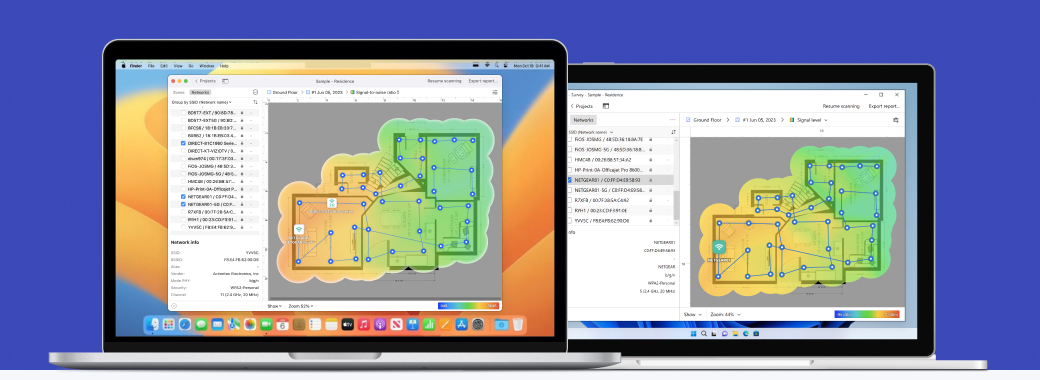
IEEE 802.11mc support, also known as Wi-Fi Round Trip Time (RTT). Thanks to this feature, devices running Android 9 Pie could soon natively support precise indoor positioning and even indoor navigation with a precision of 1-2 meters, which is a huge reason to get excited about it.
IEEE 802.11mc is the third maintenance/revision group for the IEEE 802.11 WLAN standards, which specify the set of media access control and physical layer protocols for implementing wireless local area network Wi-Fi communication in various frequencies.
The very first IEEE 802.11 standard, now called 802.11 legacy, was released in 1997, offering two net bit rates of 1 or 2 Mbps. Virtually no protocols described by 802.11 legacy are in use today. However, the same cannot be said about the 802.11b standard, which was released in 1997 and extended throughput up to 11 Mbps using the 2.4GHz band. One unofficial retronym for 802.11b is Wi-Fi 1, which says a lot about it.
In 2003, 802.11g extended throughput to up to 54 Mbps, and 802.11n introduced standardized support for multiple-input-multiple-output, frame aggregation, and security improvements, among other features in 2009.
The latest generation of wireless devices is characterized by support for 802.11ac, which provides high-throughput wireless local area networks on the 5 GHz band and has multi-station throughput of at least 1 Gbps and single-link throughput of at least 500 Mbps.
In addition to these major standards, there were many minor standards and amendments, including 802.11m, which was completed from 2007 to 2016.
IEEE 802.11mc is geared toward maintaining the IEEE 802.11 standard and related documentation and comprises of all IEEE 802.11 amendments and revisions applied to the IEEE 802.11 standard for wireless local area network services and compatible devices.
Even though the purpose of IEEE 802.11mc was never to introduce new features, several minor features were added to the IEEE 802.11 standard via IEEE 802.11mc. One such feature is known as Wi-Fi Round Trip Time (RTT), and its purpose is to allow devices to measure the distance to nearby Wi-Fi routers and determine their indoor location with a precision of 1-2 meters.
One obvious application of this feature is to improve Google’s “Find My Device” service, which is probably why Google has decided to introduce support for Wi-Fi RTT in Android 9 Pie.
“The Wi-Fi Round Trip Time (RTT) feature in Android 9 enables supporting devices to measure a distance to other supporting devices: whether they are Access Points (APs) or Wi-Fi Aware peers (if Wi-Fi Aware is supported on the device). This feature, built upon the IEEE 802.11mc protocol, enables apps to use enhanced location accuracy and awareness,” explains Google.
Besides lost device tracking, Wi-Fi RTT could also be used to enable smart automation. For example, smartphone users could program their home lights to automatically turn on when they enter a specific room or their front door locks to unlock when they get back home from work.
To protect the privacy of its users, Google is randomizing the MAC address used during Wi-Fi RTT transactions. Without MAC address randomization, hackers could abuse Wi-Fi RTT to spy on smartphone users and track their location.
IEEE 802.11mc protocol is relatively new, so it shouldn’t come as a surprise that not all devices support it at the moment. Google has promised to add support for Wi-Fi RTT to the Google Wi-Fi mesh router by the end of 2018, but the company has kept quiet about it since.
Fortunately, there’s the Compulab WILD WiFi RTT router, which is available with Intel Atom x7-E3950, Intel Atom x5-E3930, or Intel Celeron J3455. The router has 2 Gbit Ethernet ports, and it comes with Intel 8260AC card with Wi-Fi 802.11ac/802.11mc FTM, Bluetooth 4.2, and two antennas.
If you decide to purchase an 802.11mc-compatible router, you should definitely use a professional app for wireless site surveys, Wi-Fi analysis, and troubleshooting like NetSpot to reveal areas of channel interference and dead zones.
NetSpot works on macOS and Windows, and you would be hard-pressed to find an easier wireless site survey software. When you launch the application, you can choose between two distinct modes of operation. Discover mode collects every detail about surrounding Wi-Fi networks and presents wireless data as an interactive table, while Survey mode lets you easily create interactive color-coded heat maps on all surveyed wireless networks in every point of the map.
NetSpot works with all standard 802.11a/b/g/n/ac/ax wireless network adapters and supports 2.4 GHz and 5 GHz frequency bands at 20/40/80/160 MHz channels. Despite its professional features and easy-to-use interface, you can download it for free to troubleshoot and improve your network’s coverage, capacity, performance, and other parameters.

IEEE 802.11mc protocol introduces a feature known as Wi-Fi Round-Trip-Time, which makes it possible to measure the distance to nearby Wi-Fi routers with a precision of 1-2 meters. Google expects the feature to be a game-changer when it comes to indoor mapping, but it will still take some time before 802.11mc-compatible devices hit the market.
At the moment, Android developers can experiment with the feature in Android 9 Pie, which is the ninth major update and the 16th version of the Android operating system.